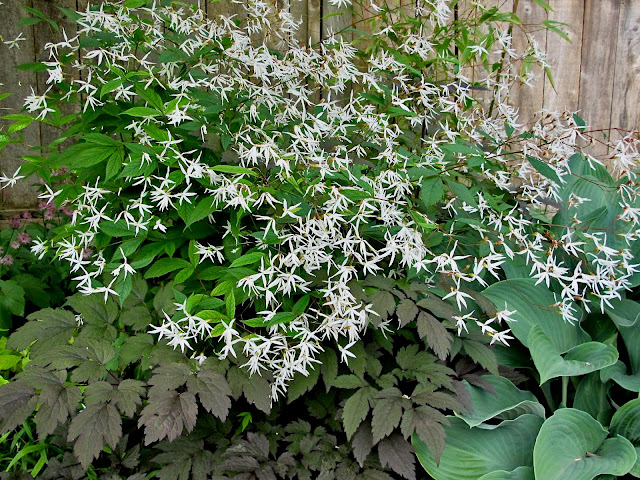If April is yellow, then May is blue - at least, it is in my garden.
One of the most vibrant blues comes from Geranium 'Terre Franche', whose wiry flower stems rise above a compact clump of contrasting green foliage.
Close by, spikes of Salvia officinalis, the familiar kitchen sage, bloom in similar colours but contrasting shape.
It may not be quite as attractive to me as the geranium, but it is certainly more so to the bees that bustle around it. A single hummingbird is another daily visitor. This year both the sage and the geranium have been particularly luxuriant and I've had to pin them from back from competing to block the narrow path that divides them.
Iris pallida 'Variegata' is worth having for just for its decorative leaves, and becomes even more dramatic when its blue flowers open.
It's now such a large clump that I'm making a note to divide it this winter. The only problem is going to be where to find space for the extras.
To the left of it, a quite different iris, less showy but to my eyes more elegant, is sending slim spears of flowers up behind our little water feature. It came to me unnamed but I think it is Iris sibirica 'Shaker's Prayer'. That's a lovely name so until I hear otherwise that's what I'm calling it.
I have three clumps of it that, with the bamboo screening behind, give a slightly Japanese air to this corner of the garden. It's a shy bloomer for me because it's in shade for at least half a day. Ideally it would like more sun.
A bolder combination occupies a dominant position in the middle of the garden. The lime-tinted leaves of oakleaf hydrangea 'Sikes Dwarf' look as if they have suddenly sprouted large cobalt-blue flowers.
In fact, these blooms belong to Clematis x durandii which is planted underneath. This clematis lacks the clinging tendrils of most vining clematis and needs a host like the hydrangea to scramble through. The two plants combine so well that visitors are occasionally fooled into thinking it a single plant.
Ajuga reptans has the mystifying common name of Bugle. A vigorous spreader, it's perfect for my sidewalk garden, which is home to various plants too enthusiastic for the main garden.
Anything that will survive in these dry beds, infested by roots from the street maple, is welcome here.
There are few plants that will cope with all-day shade but one that seems unfazed is Corydalis temulifolia 'Chocolate Stars'. Its pale blue tubular flowers are floppy, but they brighten a gloomy corner on the north side of the house.
By the time it blooms, the foliage is a tender green so you might wonder at the name. However, the reason for it is not so much the flowers but the emerging foliage, which I've celebrated in an earlier post.
It used to be called Corydalis quantmeyeriana and is still occasionally sold under that name, but this is a rare instance where the nomenclature experts have given us a shorter, more pronounceable name than the old one.
A last contender in the blue range is ice-blue Amsonia hubrichtii.
It's unusual to find flowers this pale and it needs a suitable companion not to look washed out, so I'm happy to find it a good companion for the muted pink flowers of Astrantia 'Roma'.
In the fall, the Amsonia's feathery leaves will turn golden, making it a really good two-season addition to the garden.
























